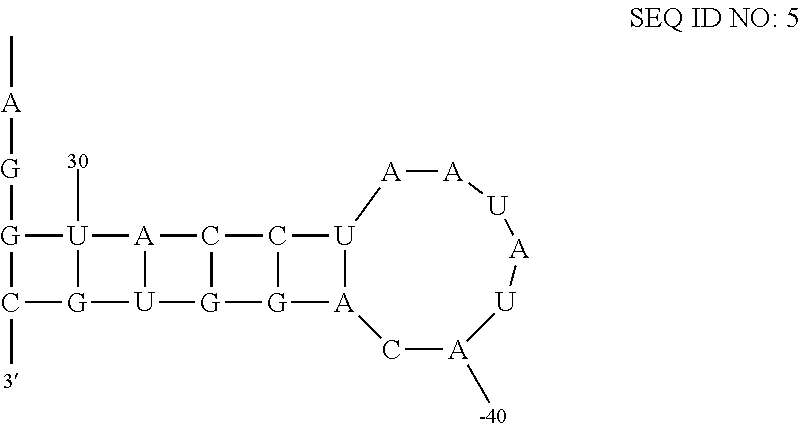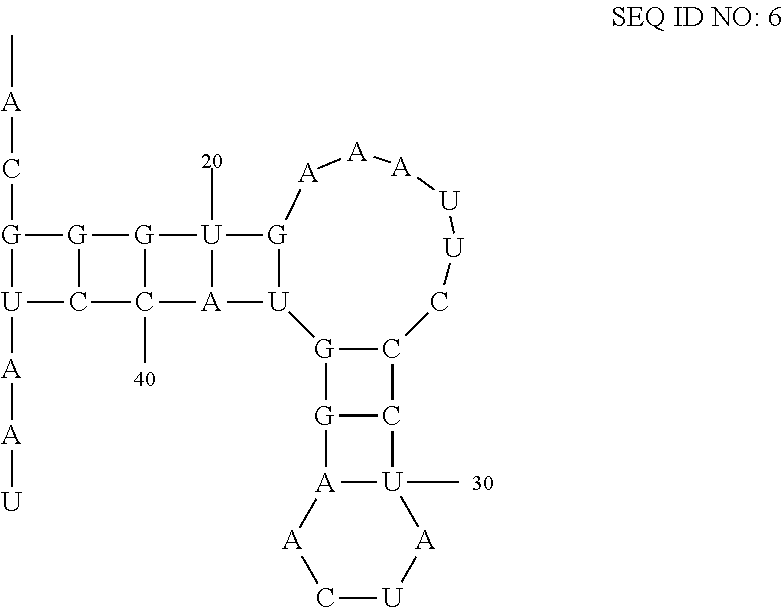Methods for treating or inhibiting infection by clostridium difficile
a technology of clostridium difficile and clostridium difficile, which is applied in the direction of biocide, peptide/protein ingredients, instruments, etc., to achieve the effect of inhibiting the ability of the bacterium to excrete toxic chemicals, different molecular recognition characteristics, and suppressing the expression of this efflux protein
- Summary
- Abstract
- Description
- Claims
- Application Information
AI Technical Summary
Benefits of technology
Problems solved by technology
Method used
Image
Examples
example 1
Binding of Compounds to Riboswitch
[0034]An in-line probing assay, as described in Regulski and Breaker, “In-line probing analysis of riboswitches”, (2008), Methods in Molecular Biology, Vol 419, pp 53-67, the contents of which are incorporated by reference, is used to estimate the dissociation binding constants for the interaction of each of the ligands described herein with a CD3299 riboswitch amplified from Clostridium difficile. Precursor mRNA leader molecules are prepared by in vitro transcription from templates generated by PCR and [5′-32P]-labeling using methods described previously (Regulski and Breaker, In-line probing analysis of riboswitches (2008), Methods in Molecular Biology Vol 419, pp 53-67). Approximately 5 nM of labeled RNA precursor is incubated for 41 hours at 25° C. in 20 mM MgCl2, 50 mM Tris / HCl (pH 8.3 at 25° C.) in the presence or absence of a fixed concentration of each ligand. Binding to the CD3299 riboswitches are measured 100 M. In-line cleavage products a...
example b
Minimum Inhibitory Concentration (MIC) Assay
[0037]The MIC assays are carried out in a final volume of 100 μL in 96-well clear round-bottom plates according to methods established by the Clinical Laboratory Standards Institute (CLSI). Briefly, test compound suspended in 100% DMSO (or another suitable solubilizing buffer) is added to an aliquot of media appropriate for a given pathogen to a total volume of 50 μL. This solution is serially diluted by 2-fold into successive tubes of the same media to give a range of test compound concentrations appropriate to the assay. To each dilution of test compound in media is added 50 L of a bacterial suspension from an overnight culture growth in media appropriate to a given pathogen. Final bacterial inoculum is approximately 105-106 CFU / well. After growth for 18-24 hours at 37° C., the MIC is defined as the lowest concentration of antimicrobial agent that completely inhibits growth of the organism as detected by the unaided eye, relative to cont...
PUM
| Property | Measurement | Unit |
|---|---|---|
| volume | aaaaa | aaaaa |
| total volume | aaaaa | aaaaa |
| minimum inhibitory concentration | aaaaa | aaaaa |
Abstract
Description
Claims
Application Information
 Login to View More
Login to View More - R&D
- Intellectual Property
- Life Sciences
- Materials
- Tech Scout
- Unparalleled Data Quality
- Higher Quality Content
- 60% Fewer Hallucinations
Browse by: Latest US Patents, China's latest patents, Technical Efficacy Thesaurus, Application Domain, Technology Topic, Popular Technical Reports.
© 2025 PatSnap. All rights reserved.Legal|Privacy policy|Modern Slavery Act Transparency Statement|Sitemap|About US| Contact US: help@patsnap.com



